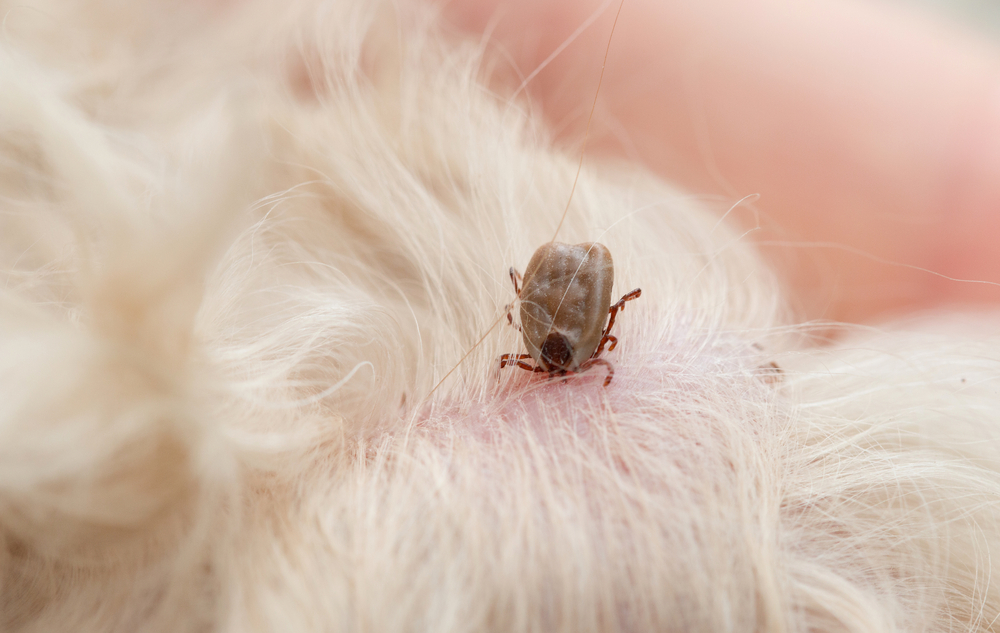Ticks are an important vector for a variety of serious diseases that can cause lifelong illness for pets and people. But, knowing what you must do if you find a tick on your pet can help prevent disease transmission and keep your family safe.
Why is checking your pet for ticks important?
Ticks may be tiny, but they can cause big problems for your four-legged friend. Ticks can transmit numerous diseases that can linger, despite treatment, throughout your pet’s life. For example, once a black-legged tick has transmitted Lyme disease to your pet, the bacteria can harbor in their kidneys and cause illness flare-ups, despite a course of antibiotics.
Checking your pet for ticks also prevents you from becoming infected with tick-borne illnesses. Removing ticks that are crawling on or attached to your pet prevents you from becoming their next warm meal, and from a tick-borne infection.
How to check your pet for ticks
Keep in mind that immature ticks are exceptionally tiny, making them difficult to spot as they crawl through your pet’s fur. Tick larvae and nymphs may be no larger than a poppy seed, so you may have to literally comb through your pet’s fur with a fine-tooth comb.
When checking your pet for ticks, a nose-to-tail search works best. Start at your furry pal’s head, and look inside their ears, around their eyes, and under their collar. Ticks have been found attached to pets’ eyes and embedded under the gum line, so no spot is safe from these insidious pests. Next, work your way down your pet’s body, checking between their legs and their toes, and under their tail. If you feel any small lump on their skin, part their fur, and examine the lump closely.
How to remove a tick from your pet
If you find a tick attached to your pet, do not use any substance for removal. Applying olive oil, nail polish remover, or heat will not make ticks detach, despite common misconceptions. These methods can actually do more harm than good, and you should use only a pair of fine-tipped tweezers or a special tick-removal product.
Have a helper hold your pet still, if possible. Then, part your pet’s fur down to the skin, grasp the tick as close as possible to your pet’s skin without pinching, and slowly and steadily pull upward to remove the tick. Check the bite site to ensure you removed the tick’s head and mouthparts and, if not, try again. Avoid squeezing the tick’s body, because the tick will essentially inject pathogens into your pet.
Place the tick in a jar of rubbing alcohol and take a clear picture to help with identification of the tick should your pet become ill. Clean the bite spot with antiseptic, and wash your hands thoroughly.
What to monitor in your pet after removing a tick
Some ticks can transmit pathogens in as little as 15 minutes, while others require 48-hour attachment to your pet to spread disease. If you removed an attached tick from your pet, be on the lookout for the following tick-borne illness signs:
- Lethargy
- Fever
- Lameness
- Swollen joints
- Enlarged lymph nodes
- Inappetence
Some tick-borne diseases can cause bleeding and bruising problems or neurologic signs, so monitor your pet carefully for any abnormalities. Pets with tick-borne illnesses may not develop clinical signs for months, while other pets may never show signs at all.
How to prevent ticks on your pet

Prevention is key to protecting your pet from tick-borne diseases. The following methods can help keep these multi-legged parasites at bay:
- Avoid tick habitats — Stick to the middle of the path in wooded areas. Avoid brushing against tall grasses and shrubs, where ticks quest for their next meal by climbing up high and waving their legs, hoping to catch a ride on a pet or person who walks past.
- Mow your lawn — Ticks tend to avoid short grass, and their host species, like small rodents and wildlife, also prefer to live in tall vegetation.
- Vaccinate your pet — Ask our Dr. Burnett if vaccinating your dog for Lyme disease is right for your pet.
- Administer tick prevention — Year-round prevention is the best way to protect your pet against the numerous threats ticks carry. Oral chewable products and topical liquid applications are equally effective at thwarting ticks, so choose the product that works best for your pet’s lifestyle.
We’ve got your pet covered from nose to tail when it comes to tick prevention—or any parasite prevention, for that matter. Give our Hearthstone Veterinary Hospital team a call to talk about the best tick prevention product for your four-legged friend.







Leave A Comment